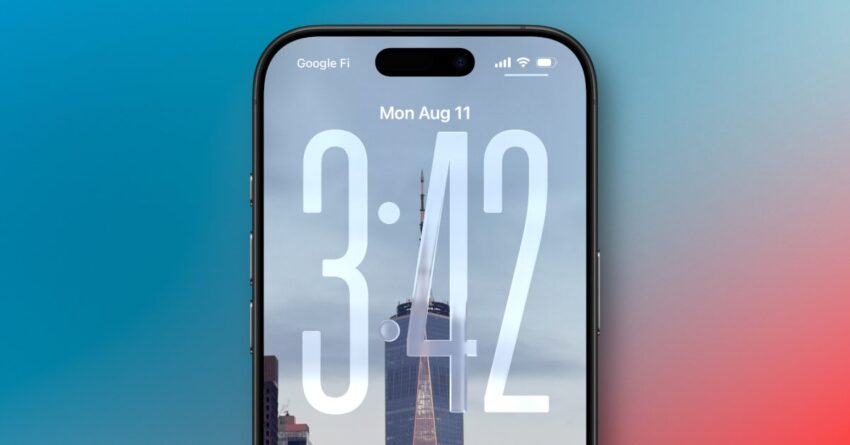
ios 26 tweaks iphone always on display Apple’s latest update, iOS 26, introduces notable changes to the iPhone’s Always On Display feature, which may not sit well with all users.
ios 26 tweaks iphone always on display
Overview of Always On Display
The Always On Display (AOD) feature was first introduced with the iPhone 14 Pro, allowing users to glance at essential information without fully waking their devices. This feature has been praised for its convenience, enabling quick access to notifications, time, and other widgets while preserving battery life. The display dims significantly when not in use, ensuring that it does not consume excessive power.
Since its inception, the AOD has maintained a consistent design and functionality. However, with the rollout of iOS 26, Apple has made subtle yet impactful changes that could alter the user experience significantly.
Changes in iOS 26
With the introduction of iOS 26, Apple has implemented a new wallpaper blur effect for the Always On Display. This change aims to enhance the visual aesthetics of the AOD, but it has also raised concerns among users regarding its practicality and functionality.
Wallpaper Blur Effect
The most prominent change is the addition of a blur effect applied to the wallpaper when the Always On Display is activated. This effect is designed to create a more visually appealing interface by softening the background image, allowing the time and notifications to stand out more clearly. While this may seem like a minor adjustment, it has significant implications for user experience.
Many users have expressed dissatisfaction with this new feature. The blur effect can obscure intricate details of the wallpaper, diminishing the overall aesthetic appeal that users may have chosen for their devices. For those who take pride in their personalized wallpapers, this change may feel like a loss of individuality.
User Reactions
Feedback from the user community has been mixed. Some appreciate the new design, noting that it makes the time and notifications easier to read. Others, however, have voiced their concerns on various forums and social media platforms, arguing that the blur effect detracts from the overall experience of using the Always On Display.
One user commented, “I loved how my wallpaper looked on the Always On Display, but now it feels like I’m looking at a foggy window.” This sentiment reflects a broader frustration among users who feel that Apple’s design choices sometimes prioritize aesthetics over functionality.
Implications of the Change
The introduction of the blur effect raises questions about Apple’s design philosophy and its commitment to user customization. Historically, Apple has been known for its focus on simplicity and elegance in design, but this change may suggest a shift towards a more standardized aesthetic that could alienate some users.
Impact on User Customization
Customization has always been a significant aspect of the iPhone experience. Users often invest time in selecting wallpapers that reflect their personality or mood. The new blur effect may limit the ability to showcase these personal choices effectively. As a result, users may feel less inclined to personalize their devices, leading to a more uniform appearance across iPhones.
Potential for Future Updates
Given the mixed reactions to the blur effect, it is possible that Apple may consider user feedback in future updates. The company has a history of responding to user concerns, and if the feedback regarding the Always On Display is substantial enough, it could lead to adjustments or even the option to disable the blur effect entirely.
Technical Considerations
From a technical standpoint, the implementation of the blur effect may have implications for battery life and performance. While the Always On Display is designed to be energy-efficient, any additional processing required to create the blur effect could potentially impact battery consumption. Users who prioritize battery life may find this change concerning, particularly if they rely heavily on the AOD feature throughout the day.
Battery Life Concerns
Apple has made significant strides in optimizing battery performance across its devices, and users have come to expect a certain level of efficiency. If the blur effect leads to increased battery drain, it could prompt users to reconsider their usage of the Always On Display. This could ultimately affect how often users check their notifications and time, potentially leading to a less engaged user experience.
Performance and Responsiveness
In addition to battery life, the performance of the Always On Display feature itself may be impacted. Users have reported varying degrees of responsiveness with the AOD, and any additional processing required for the blur effect could exacerbate these issues. If the feature becomes sluggish or unresponsive, it could lead to frustration among users who rely on it for quick access to information.
Comparative Analysis with Competitors
Apple’s Always On Display feature is not unique to the iPhone. Many Android devices have offered similar functionality for years, often with more customization options. As Apple continues to refine its AOD feature, it may be worth examining how competitors handle similar functionalities.
Customization in Android Devices
Many Android manufacturers allow users to customize their Always On Display settings extensively. Options may include different clock styles, notification layouts, and even the ability to disable certain features like blur effects. This level of customization can enhance user satisfaction, as individuals can tailor their devices to suit their preferences.
In contrast, Apple’s approach has historically favored a more uniform design language. While this can create a cohesive user experience, it may also limit the ability for users to express their individuality through their devices. As competition in the smartphone market continues to intensify, Apple may need to reconsider its stance on customization to remain competitive.
Looking Ahead
The changes introduced in iOS 26 regarding the Always On Display feature highlight the delicate balance between aesthetics and functionality. As Apple navigates user feedback, it will be crucial for the company to consider how these changes impact the overall user experience.
Future Updates and User Feedback
As the technology landscape evolves, so too will user expectations. Apple has a track record of listening to its user base, and the feedback surrounding the AOD blur effect may prompt future updates that address these concerns. Whether through the option to disable the blur effect or additional customization features, Apple has the opportunity to enhance the AOD experience for its users.
Conclusion
In conclusion, the changes brought about by iOS 26 to the Always On Display feature represent a significant shift in Apple’s design philosophy. While the introduction of the blur effect may appeal to some users, it has also sparked considerable debate regarding user customization and functionality. As Apple continues to refine its offerings, the balance between aesthetics and practicality will remain a critical consideration for the company and its users alike.
Source: Original report
Was this helpful?
Last Modified: October 23, 2025 at 9:38 am
2 views















